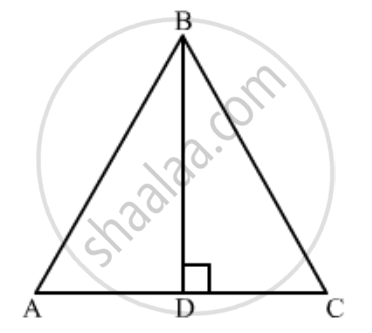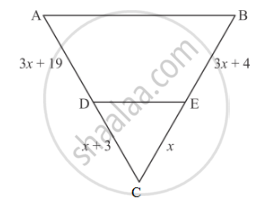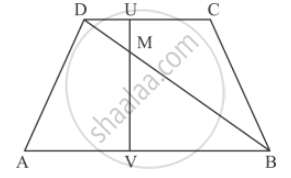Advertisements
Advertisements
प्रश्न
In ∆ABC, given that AB = AC and BD ⊥ AC. Prove that BC2 = 2 AC. CD
उत्तर

Since Δ ADB is right triangle right angled at D
`AB^2=AD^2+BD^2`
Substitute `AB=AC`
`AC^2 =AD^2+BD^2`
`AC^2=(AC-DC)^2+BD^2`
`AC^2=AC^2+DC^2-2AC.DC+BD^2`
`2AC.DC=AC^2-AC^2+DC^2+BD^2`
`2AC.DC=DC^2+BD^2`
Now, in Δ BDC, we have
`CD^2+BD^2=BC^2`
Therefore , `2AC.DC = DC^2+BD^2`
`2AC.DC=BC^2`
Hence proved.
APPEARS IN
संबंधित प्रश्न
In a ΔABC, AD is the bisector of ∠A.
If AB = 6.4cm, AC = 8cm and BD = 5.6cm, find DC.

In a ΔABC, AD is the bisector of ∠A.
If AB = 5.6cm, AC = 4cm and DC = 3cm, find BC.

In each of the figures [(i)-(iv)] given below, a line segment is drawn parallel to one side of the triangle and the lengths of certain line-segment are marked. Find the value of x in each of the following :

What values of x will make DE || AB in the given figure?

In the given figure,

AB || DC prove that
DM × BV = BM ✕ DU
In ∆ABC, ∠A = 60°. Prove that BC2 = AB2 + AC2 − AB . AC.
In the figure given below DE || BC. If AD = 2.4 cm, DB = 3.6 cm, AC = 5 cm. Find AE.
The areas of two similar triangles ∆ABC and ∆DEF are 144 cm2 and 81 cm2 respectively. If the longest side of larger ∆ABC be 36 cm, then the longest side of the smaller triangle ∆DEF is
The length of the hypotenuse of an isosceles right triangle whose one side is\[4\sqrt{2} cm\]
In an equilateral triangle ABC if AD ⊥ BC, then
